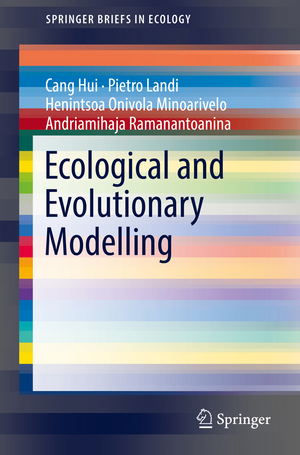Ecological and Evolutionary Modelling: SpringerBriefs in Ecology
Autor Cang Hui, Pietro Landi, Henintsoa Onivola Minoarivelo, Andriamihaja Ramanantoaninaen Limba Engleză Paperback – 27 iun 2018
The aim of this book is to (i) introduce key concepts in ecology and evolution, (ii) explain classic and recent important mathematical models for investigating ecological andevolutionary dynamics, and (iii) provide real examples in ecology/biology/environmental sciences that have used these models to address relevant issues. Readers are exposed to the key concepts, frameworks, and terminology in the studies of ecology and evolution, which will enable them to ask the correct and relevant research questions, and frame the questions using appropriate mathematical models.
Preț: 476.42 lei
Nou
Puncte Express: 715
Preț estimativ în valută:
91.16€ • 95.18$ • 75.45£
91.16€ • 95.18$ • 75.45£
Carte tipărită la comandă
Livrare economică 04-18 aprilie
Preluare comenzi: 021 569.72.76
Specificații
ISBN-13: 9783319921495
ISBN-10: 3319921495
Pagini: 115
Ilustrații: IX, 86 p. 17 illus., 3 illus. in color.
Dimensiuni: 155 x 235 mm
Greutate: 0.15 kg
Ediția:1st ed. 2018
Editura: Springer International Publishing
Colecția Springer
Seria SpringerBriefs in Ecology
Locul publicării:Cham, Switzerland
ISBN-10: 3319921495
Pagini: 115
Ilustrații: IX, 86 p. 17 illus., 3 illus. in color.
Dimensiuni: 155 x 235 mm
Greutate: 0.15 kg
Ediția:1st ed. 2018
Editura: Springer International Publishing
Colecția Springer
Seria SpringerBriefs in Ecology
Locul publicării:Cham, Switzerland
Cuprins
Preface.- 1. Biodiversity1.1. Introduction.- 1.2. Aggregation.- 1.3. Entropy.- 1.4. Coexistence.- 1.5. Co-occurrence.- 1.6. Species turnover.- 1.7. Scaling.- 2. Evolution.- 2.1. Introduction.- 2.2. Phylogeny.- 2.3. Optimality.- 2.4. Game theory.- 2.5. Adaptive dynamics.- 2.6. Evolutionary branching.- 3. Networks.- 3.1. Introduction.- 3.2. Network architecture.- 3.3. Network stability.- 3.4. Complexity-stability relationship.- 3.5. Interaction switching.- 3.6. Coevolutionary networks.- 4. Spread.- 4.1.Introduction.- 4.2. Random walks.- 4.3. Metapopulations.- 4.4. Landscape demography.- 4.5. Dispersal kernels.- 4.6. Species distribution models.- References.- Index
Notă biografică
C. Hui is a Professor of Mathematics and the South African Research Chair (SARChI) in Mathematical and Theoretical Physical Biosciences based at Stellenbosch University and the African Institute for Mathematical Sciences in South Africa. His research focuses on developing models and theories for explaining emerging patterns of biodiversity, networks, and traits in ecology and evolution. CH has published more than 190 papers and received the Elsevier Young Scientist Award in 2011. CH and David M. Richardson authored the book Invasion Dynamics (Oxford University Press). CH is a core-team member of the DST-NRF Centre of Excellence for Invasion Biology and is on the editorial board of several journals, including Biological Invasions (Springer), BMC Ecology (BioMed Central), Ecological Complexity (Elsevier), Insect Conservation and Diversity (Wiley), and Frontiers in Ecology and Evolution.
P. Landi is a Postdoctoral Fellow at Stellenbosch University and Visiting Scientist at the International Institute for Applied Systems Analysis (IIASA, Austria). He received his PhD with distinction in Information and Communication Technology from Politecnico di Milano in 2014 and involved in the Southern African Young Scientists Summer Programme as a co-supervisor. His main research interests include modelling evolutionary dynamics in socio-ecological systems. PL has published 10 papers and co-authored the book Modelling Love Dynamics (World Scientific).
H.O. Minoarivelo is a Postdoctoral Fellow at Stellenbosch University. She received her MSc in Computer Science and PhD in Mathematical Ecology from the same university. Her work focuses on the eco-evolutionary dynamics of mutualistic networks. She has published 6 papers and co-authored a book chapter (Springer).
A. Ramanantoanina is a Postdoctoral Fellow currently at the University of Western Cape. She received her PhD in Mathematics from Stellenbosch University. Her research focuses on modelling spatial and trait dynamics of ecological systems using partial differential equations. She has published 5 papers and co-authored one book chapter (Springer).
Textul de pe ultima copertă
Ecology studies biodiversity in its variety and complexity. It describes how species distribute and perform in response to environmental changes. Ecological processes and structures are highly complex and adaptive. In order to quantify emerging ecological patterns and investigate their hidden mechanisms, we need to rely on the simplicity of mathematical language. Ecological patterns are emerging structures observed in populations, communities and ecosystems. Elucidating drivers behind ecological patterns can greatly improve our knowledge of how ecosystems assemble, function and respond to change and perturbation. Mathematical ecology has, thus, become an important interdisciplinary research field that can provide answers to complex global issues, such as climate change and biological invasions.
The aim of this book is to (i) introduce key concepts in ecology and evolution, (ii) explain classic and recent important mathematical models for investigating ecological andevolutionary dynamics, and (iii) provide real examples in ecology/biology/environmental sciences that have used these models to address relevant issues. Readers are exposed to the key concepts, frameworks, and terminology in the studies of ecology and evolution, which will enable them to ask the correct and relevant research questions, and frame the questions using appropriate mathematical models.










